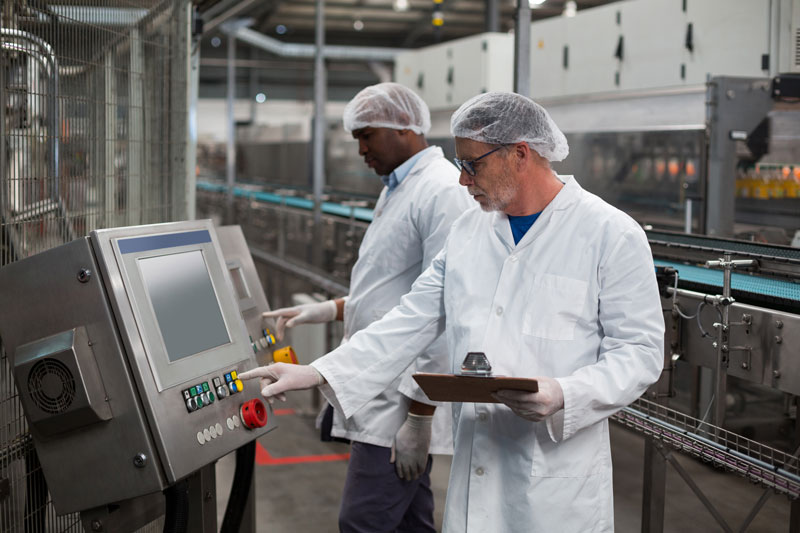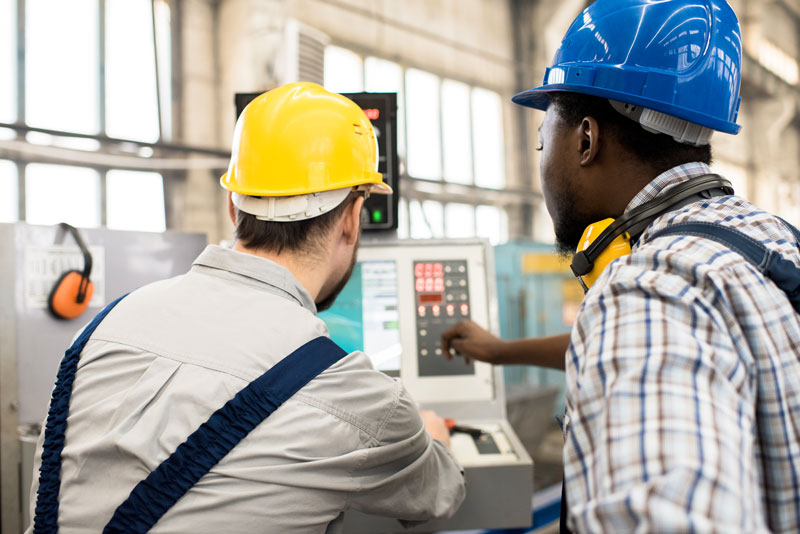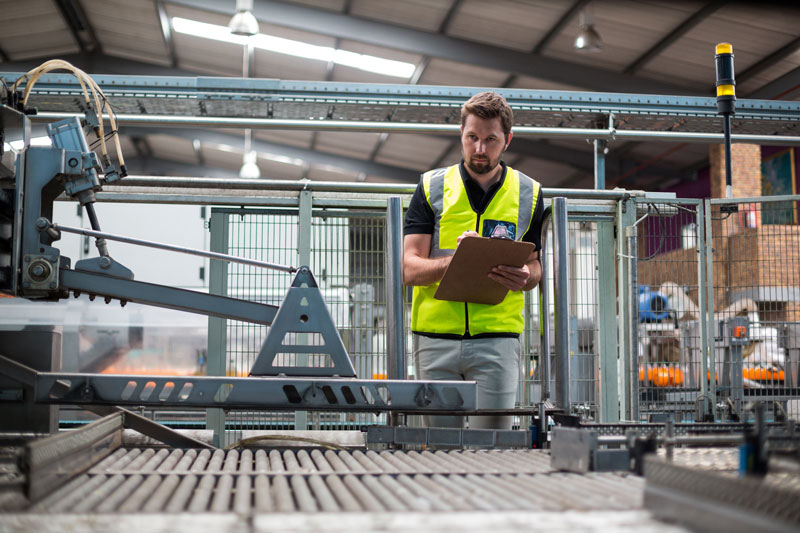Businesses in the manufacturing industry are under constant pressure to improve the speed and efficiency of manufacturing processes. It is essential that this occurs to cut costs and remain competitive in a tumultuous economic environment.
Often the factor which slows down the manufacturing process is human workers operating on the production lines. If the input of human workers is removed, theoretically, manufacturing companies could increase productivity and improve the output of the factory as a whole.
A business like this is referred to as a fully automated factory or a lights out factory.
What Is Lights Out Manufacturing?
The concept of a fully automated factory relies on the lights out manufacturing methodology.
Lights out manufacturing is a manufacturing process that utilizes a completely automated factor that has little to no human interactions. Indeed, human workers are not required for a factory like this to operate effectively.
While a human presence is not required, lights out factories do need countless different pieces of technology to complete automated processes within the business model. This could include industrial robots operating on the factory floor and even various forms of artificial intelligence.
Manufacturing processes would also typically depend on both high-frequency data collection as well as machine learning.
Lights out operations have been a dream for professionals in the manufacturing industry for decades. Business owners love the idea of showing up to work and setting up the machines without the requirement of human intervention. Theoretically, with this type of setup, once the machines are set up, the lights can be switched off and the factory can be left to function independently until the end of the day.
These fully automated factories are referred to as lights out manufacturing.
It is widely assumed that a lights out factory is still a pipe dream and that human labor is still necessary for a business to run effectively. However, this is not the case.
The first attempt at a lights out factory dates back to 1980. During this time, IBM built a lights-out factory in Texas to produce computer keyboards. The project was not successful due to the inflexibility of the systems that were put in place.
GE Also set up a lightbulb factory in 2010 that only required a few human workers to create the finished products.
More recently, attempts at establishing full lights out factories have been successful. Development into this methodology has occurred around the world. One example can be found in the Netherlands. Philips has successfully set up automated factors for the production of electric razors. The only role of human workers here is quality assurance and there are just nine workers operating in this capacity.

Drivers For Lights Out Manufacturing
There are various drives pushing manufacturers to achieve total automation in their factories.
Lower The Cost Of Production
Many manufacturers are keen to achieve full automation in their factories so that they can reduce the cost of different tasks. While there is always going to be a significant upfront cost, increased levels of automation will be less expensive in the long run. This is critical as manufacturers need to start exploring the future.
Improved Efficiency
Teams of employees have a range of requirements that must be met. This includes breaks, time off and even shift changes. Automated robots have none of these requirements. The robots used in the factors can function 24/7, pushing efficiency rates to new levels never seen before.
Increased Sustainability
The processes required to manufacture any product often requires a massive level of raw materials. Many of these materials are wasted which increases the carbon footprint of the plant or factory. Increased levels of sustainability is something which customers are already demanding from businesses that they buy from. Material waste can be reduced with the right automated setup.
Avoid Downtime
Many factories that experience downtime find the cause was due to human error. Indeed, it is estimated that 23% of all downtime is caused by issues that stem from human error. Through automation and the use of the right technology, issues here can be eliminated.
Automation can also ensure that manufacturing companies benefit from planning downtime. Downtime like this can ensure that maintenance on robotics and other types of technology are completed without disrupting the output of the facility.
Improve Quality
Automating manufacturing can also lead to improved levels of quality overall. Again, this is due to the elimination of issues with human error which can lead to mistakes and discrepancies in the standard of production, even when using the latest technology.
Factories can also use the latest technologies to create customized products. This has become a significant demand for virtually every industry. Automating processes ensures that customized products can be created to the right standards of quality.
A Safer environment
Automation on a significant scale could also lead to less issues with accidents and incidents. A safer workplace thanks to the right level of automation will further reduce costs and avoid headaches for business owners.

What Is Preventing The Fully Automated Factories Becoming The Norm?
Despite the various drives pushing for the development of lights out manufacturing, there are some roadblocks that must be addressed.
Financial Limitations
Currently the robots required to fully automate a factory and complete various tasks are expensive. Indeed, they may be too expensive for small manufacturing firms to justify the benefits that this type of setup can provide. Furthermore, there are countless countries around the world where the costs of labor are cheap enough that the long term savings do not provide the right incentive.
Tech Limitations
There are also tech limitations in terms of creating the robots that are capable of pushing this methodology. This isn’t just about the costs of creating the machines required. There have been significant setbacks in terms of processing, feedback and connectivity. Even the most powerful advocates have reduced their support for automation due to the issues here. However, this is not expected to be a problem in the future as technologies continue to evolve overtime. The ability of the robotics that are created will improve.
The Most Successful Lights Out Factory That Exists Today
Automation already exists in manufacturing companies across the globe. One staging example can be found in China. Xpeng Motors launched a factory based on full automation across more than 3000-acres. Throughout the plant, 264 robots designed with the latest technologies work on countless processes to complete the production of vehicles.
Rigorous testing has verified the quality standards of the different processes involved with many viewing factories like this as the future of manufacturing. Processes that are completed by the robots include aluminum plate riveting, welding and gluing. A process like plate riveting can be completed in far less time through the process of automation. This is just one of the many examples for the benefits that a factory like this could provide.
The robots also complete the various tasks with an energy saving of more than 30%, providing evidence that automation can lead to higher levels of sustainability as well as lower costs.
What Is The Role Of Human Workers In Fully Automated Factories?
When the right technologies are used, human workers are no longer required. Software, machines and various other components eliminate the need for a full work force. However, the assumption this will put employees out of work is not true. Instead, employees will be required to learn new skills and will be integral to developing the software required. As well as designing and developing the systems and software, it is also likely that humans will still be needed to complete maintenance on the machines.
Workers are also still required to monitor the different systems and ensure that tasks are being completed. For instance, it’s possible that a machine stopped running overnight. This could have a huge impact and mean that tasks are not being completed. That’s why it’s important to have a team to monitor the systems even if they are operating remotely.
Of course, eventually, this may no longer be a requirement. It’s possible that thanks to advances in machine learning, software could be used to monitor the various systems and then alert someone of a problem only when necessary. The latest advances are driving the sector towards this level of automation. However, for now it is likely that employees will still have a part to play, albeit a different one from what they are perhaps used to.

Conclusion
Regardless of the costs and the current limitations in terms of software and technology, it is clear that the future for manufacturers is full automation. According to the World Robotics 2021 robots report, there were more than 3 million industrial robots operating in factories in 2021. That was an increase of 10% and it is expected that number will surge over the next decade.
Software is also constantly evolving with machine learning being widely used in various processes including in the production of countless items. The demand already exists. As well as taking a key role in companies across the globe, it is likely that these technologies also become far more sophisticated.
